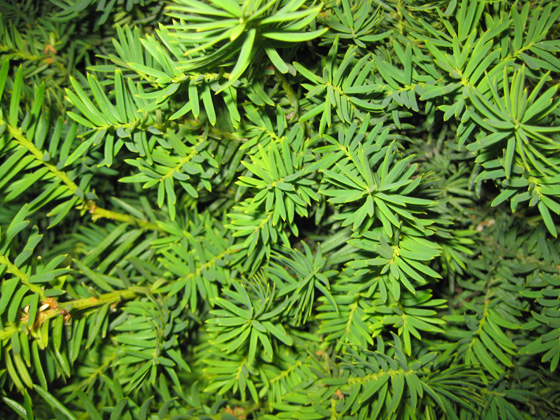| PSC 2620: Woody Trees and Shrub | Course Home | Week 12 |
Taxus cuspidata - Japanese Yew
Plant Viewer
 |
 |
| The needles of Taxus cuspidata are 1/2 - 1 inch long and radiate irregularly around the stem. | A single seed is enclosed by a fleshy red casing. Image: Kurt Stueber |
Plant Description
Taxus cuspidata, or Japanese Yew, is a small to medium coniferous evergreen tree, or large shrub. It grows slowly to 10-40 feet tall with a wider spread. There is a great deal of variation in its form, and it can be tall and upright to broad and spreading. It prefers to grow in moist, well-drained soil and performs better in soils that are slightly acidic. In our climate it grows best in part to full shade, but will grow in full sun in more temperate and humid climates.
The attractive bark is reddish-brown in color and exfoliate in small plates. Young stems are a light green color the first year, and turn reddish-brown the second. The foliage is composed of short (1/2 to 1 inch) and wide needles with a distinct point on their ends. The needles are a dark glossy green color on the top and a paler green below. While they are arranged on either side of the stem, their spacing and placement is not as symmetrical as on Taxus baccata. Needles are often arranged in a more alternate pattern or stray needles will form above or below the stem.
The fruit is composed of a single olive colored seed surrounded on all sides, except the bottom, by a fleshy red berry-like covering. Male and female flowers both occur on the tree. The male flowers occur in tiny clusters, while the female flowers form singly. Neither are ornamentally important.
Landscape Use
The most common cultivars are shrub forms that are suitable for use as a foundation planting, hedge or in mass plantings. Taxus cuspidat is a good selection for an evergreen that can tolerate full shade.
Points of Interest
All parts of Japanese Yew is highly poisonous if ingested. Species of Taxus remain one of the leading causes of horse and cattle poisoning. Do not plant where it may be eaten by livestock!